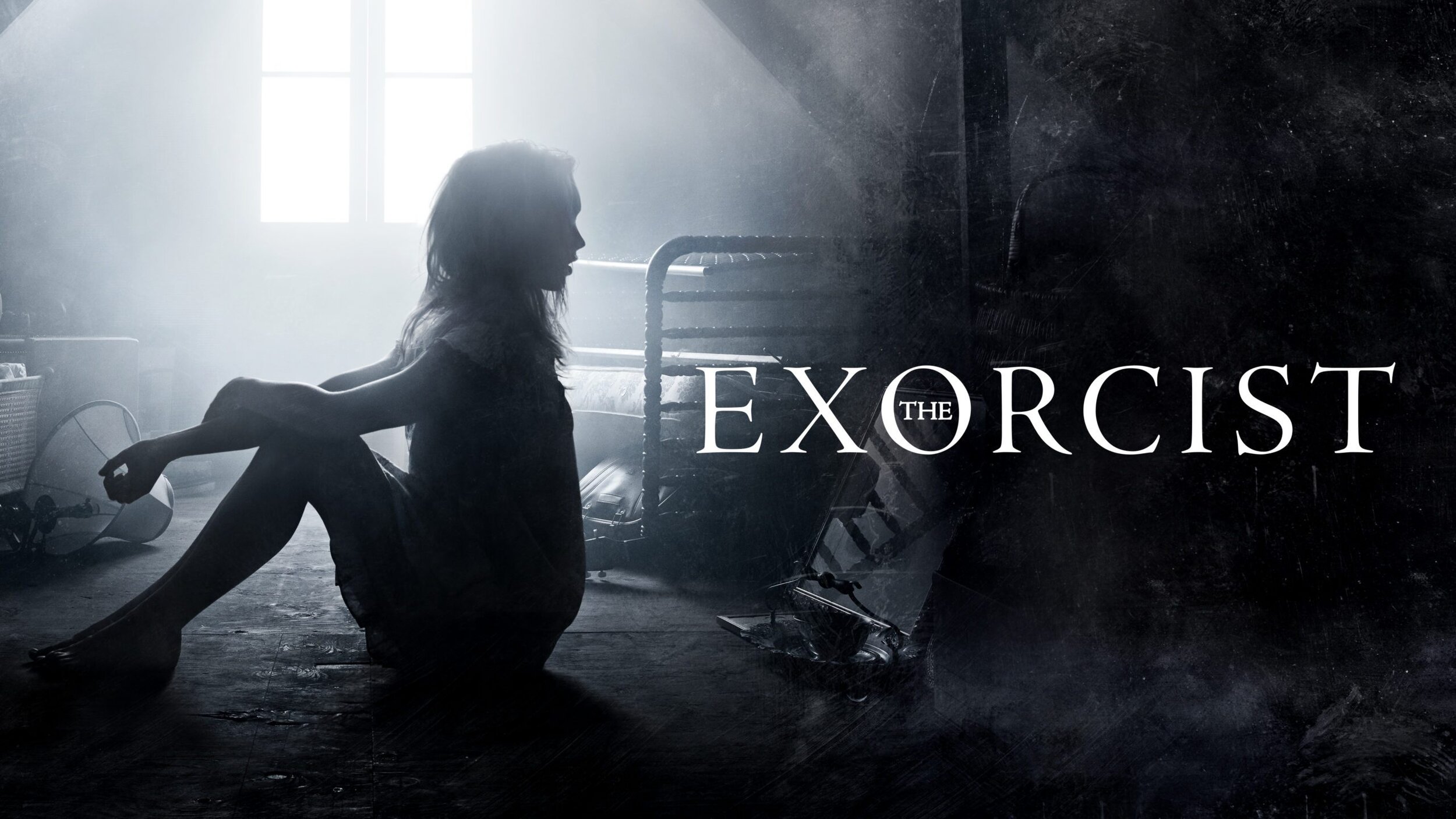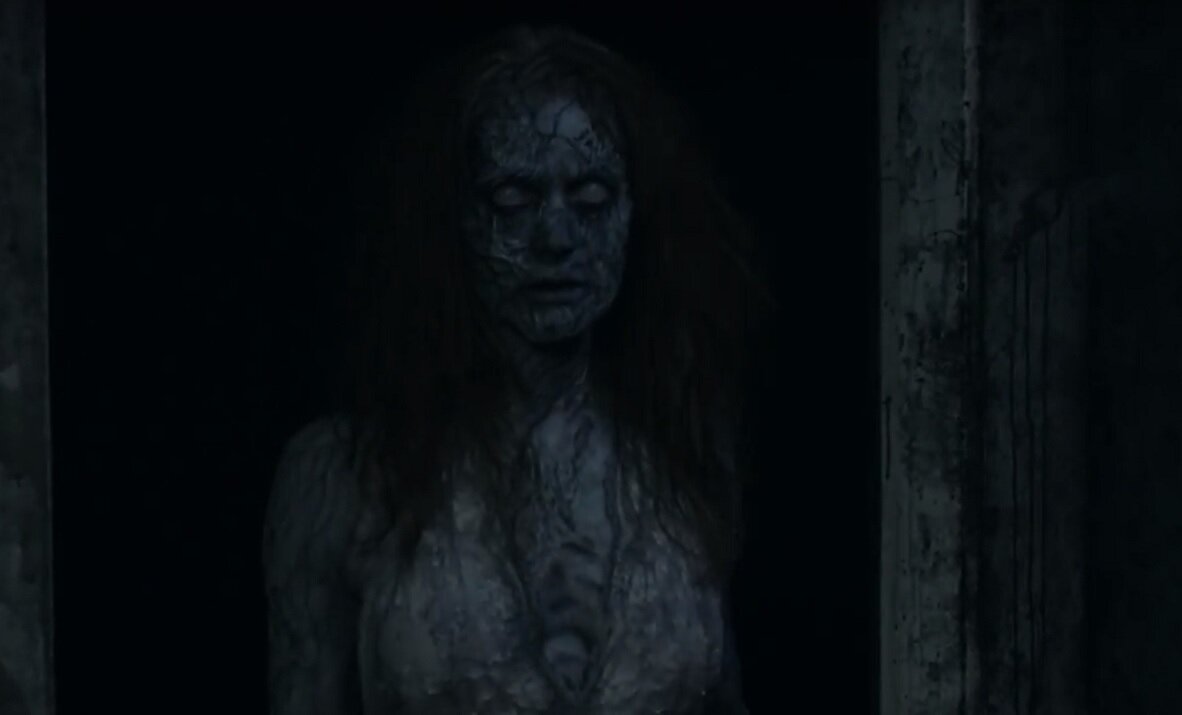[TV Review] The Exorcist
Both seasons available on Amazon Prime (UK) and Hulu (USA)
On 11th May 2018 The Exorcist was cancelled after two seasons, joining the ranks of other horror television shows that deserved more time, including Bryan Fuller’s Hannibal. However, both The Exorcist and Hannibal leave a mark as shows that managed to strain against network television restrictions to deliver on material that was as beautiful as it was horrific.
Taking on any new approach to a long standing and much-loved horror classic is a gutsy move. The initial publicity material for The Exorcist was something of a concern, seemingly putting uncanny effects and contortions at the forefront. Creator Jeremy Slater was responsible for screenplay work on the maligned Fantastic Four (2015) and the better-received but less well-known Pet (2016) so, to some degree, was still an unknown quantity. The Exorcist had already received variable (to put it mildly) responses to spin-off, prequel and sequel efforts so expectations were reasonably low from horror enthusiasts. Happily, the combination of confident writing, incredible casting and an understanding about what made The Exorcist so compelling is what made the show some of the most engaging, emotive television.
The stark, monochrome opening titles involving both religious and city imagery in the first season, switching to the island elements for the second season serve as an excellent scene setter. The theme tune feels like a sinister take on a whistled tune, further drawing the viewer in. While both seasons explore different cases of possession, there is a partnership of Father Tomas Ortega (Alfonso Herrera) and Father Marcus Keane (Ben Daniels) and also a wider, conspiracy-based plot linking them.
As this is a review, rather than just an appreciation piece, every effort has been made to conceal spoilers. There will be some discussion of plot points that those who have not watched the series may want to avoid and I would certainly recommend that the first season is watched without too much prior knowledge.
Season One
The first season focuses on the Rance family. On the surface, the affluent, attractive family has it all, but the house is under the shadow of something sinister. Oldest daughter Kat’s (Brianne Howey) promising dance career appears to be over before it starts, following a car accident in which her girlfriend Julia was killed. Father Henry (Alan Ruck) is coming to terms with his own brain injury and the accompanying self esteem issues it has caused him. Matriarch Angela (Geena Davis) is doing her utmost to sustain their polished image, while younger daughter Casey (Hannah Kasulka) is increasingly detached, alternating between sullen and antagonistic. The setup of the family’s woes allows the series to toy with the symptoms of possession early on, weaving a case for any of them to be the afflicted. This leads to a few moments where performances feel off-balance, but these issues are usually resolved swiftly. Upon first watch, I had found Geena Davis’ performance slightly too big, but after a more reflective second watch I can really see the beauty in it.
Whereas the original novel and film are insular, focused on one family and the impact it has on them, the series utilises its modern setting and episodic nature to push the scale. Possession in the series feels more pervasive and fluid, clinging to unspoken desires, bubbling tensions and secrets, exploiting them all to gain power and control. The media plays a vital role as the series progresses, with the events regularly making news and taking on a memetic quality, including Tomas receiving the moniker of “The Hot Priest” a few years in advance of Fleabag. The critique of modern society goes further with one scene in Chapter Three: Let ‘Em In featuring a subway train of passengers ignoring the harassment of a character in full view of everyone, only to immediately take to their phones and start recording when matters take a more violent, sensational turn.
Although the metaphor is present early on, episode 4 Chapter Four: The Moveable Feast represents a point at which the possession is most explicitly linked to the concept of coercive control and abusive relationships. Again, while the original material focuses on the possession in full flow, symptoms and true nature exposed, the series has more time to explore how that kind of entity may take hold of someone. The result is as absorbing as it is chilling. That much of the focus is on the wealthy, white Rances is called out as Marcus explores tunnels filled with marginalised people and an angry community tries to have their pain recognised in the same way. The series is consumed with showing human failings, invoking this as much in everyday behaviour as the supernatural and demonic elements.
The series further expands in its exploration of the Rance case being symptomatic of wider issues of demonic possession, including the suggestion that the Church itself has been compromised. This wider story varies in its success. The show is arguably at its best when exploring the interior lives of those impacted and the larger story is less impactful the further it moves away from humans. If humans are flawed and subject to compromise, then so are the institutions they make up. Kurt Egyiawan is a high point in this regard as Father Devin Bennett, struggling to uphold the status of the Church while acknowledging that something is not right.
With the original film being such a landmark in terms of mainstream horror cinema special effects, does the series measure up? To some degree, yes. A few effects fall a little short, relying on CGI which dates reasonably quickly but where it redeems itself is by adding further meaning to the various contortions. Crucially, the iconic head-twist is treated within the series as fatal to the possessed, rather than a demonic party trick that leaves no lasting damage. Possession here means deep, long-lasting trauma for the possessed and witnesses. There is a sense of paying homage to the original film while also adding more traumatic elements that enhance the complexity of its characters. A scene in which Father Tomas’ hidden struggle with his own desire and passion causes him to transgress against a possessed victim in a way that is genuinely skin crawling. A later scene contrasting the body as possessed and the body in passion adds considerably to the idea of secrecy and shame aiding entities in exploiting and overtaking people. Chapter Nine: 162 features a scene where everything is held in freeze frame, highlighting the beauty and detail in the set design, capturing the dramatic moment as if it were out of a religious painting.
What the series does exceptionally well is build the bridge between Tomas and Marcus, developing both their characters in the process. Tomas, by virtue of the successful relationships he has built with his congregation is a deeply sensitive people-person who is thrown by his first forays into the altogether more hostile and intense world of exorcism. Alfonso Herrera is wonderful in the role, bringing that necessary caution and more stoic moments. Ben Daniels excels as a man rethinking everything he has ever known, battling demons and the institution that has failed him. His abrasive nature combined with acerbic quipping lends the character such a strong front that it is genuinely disarming when the underlying pain and vulnerability emerges. It helps that he is given some of the season’s best lines, delivered with a cutting playfulness.
The first season is a striking exploration of a traumatic event under the glare of the media. The full picture emerges systematically, nodding at its source material while confidently bringing its own fully realised characters to the fore. In its exploration of male intimacy and passion as well as the secrets and failings that humans hide from others and even themselves, it presents a nuanced and compelling vision.
Season Two
If secrecy and denial were the dominant concerns of season one, then grief, ego and pride all take centre stage in the second. Following their time with the Rance family in Chicago, the pair have taken to the road as exorcists for hire. The wider conspiracy plot from season one remains in place, with the addition that the Church is no longer sanctioning exorcisms. As a result, Marcus and Tomas, still bedding into their working partnership are at as much risk from victim’s families as they are the demonic entities. Soon, their chain of cases leads them to an island where a grieving foster home is in turmoil and could be the next in a long line of tragedies.
Daniels and Herrera remain on top-form for the show’s second outing, perfectly showcasing the changing relationship and tensions between Marcus and Tomas. Tomas’ ego as a ‘chosen’ one threatens his stability and his inexperience begins to leave him vulnerable to breaches, showcased by numerous twisted visions and reality lapses that allow the show to indulge in some deeply creepy imagery. Tomas’ desperation to fulfil his potential and justify all his decisions feature frequently in his struggle to relate to his new life. On the other hand, Marcus appears to be at peace with no longer being involved in the Church but is still damaged by a perceived lack of connection to God. The duelling egos and desire to be special outside of the institution that defined them is a prominent concern throughout. This sense of institutions shaping people is furthered by the foster home, with its inhabitants having faced discrimination and neglect by those responsible for bringing them into the world. These themes of belonging are essential in the progression of the season, for both the central family and the developing priests.
Grief, too, plays a central role, whether that is grief in the traditional sense or the yearning for the kind of life that the characters expected. Grief is a prominent feeling in the foster home, and it is the suppression of that grief that allows the gap for the possession to take hold. In his steadfast determination and ego-driven desire to deny the impact of the loss of his wife Nicole (Alicia Witt), foster father Andy (John Cho delivering one of the most impactful performances I have seen) inadvertently leaves the house open to harm. As in the first season, family is central, although in this case it is a made family, comprised of those who have not found homes anywhere else and have a variety of issues that could make them susceptible to possession. This allows the second season to indulge in the same misdirection as the first, carefully sewing the potential for any of them to be the central threat. Verity (an astonishing performance by Brianna Hildebrand), a gay teenager subject to conversion therapy before her time at the house is hostile toward religion, something which has her clash with Shelby (the impressive Alex Barima), a more devout housemate. Caleb (Hunter Dillon) and Truck (Cyrus Arnold) have both experienced issues due to their disabilities and find themselves occasionally struggling to find their place. Across the board, the performances are exceptional, adding a great deal to the emotional content and trust me, there are many tears to be shed throughout this season.
Despite being under the banner of The Exorcist, the second season features numerous references to The Shining, in both its content and even smaller background nods like a stay in room 237 of a motel. This marks The Exorcist as a series confident that its audience will pick up on those cues. Of course, there are also overt references to the original material, with the ‘lovely day for an exorcism’ line featuring. In some ways these feel like slightly clumsier moments, especially when so far away from the source material, but provide for long-term fans, nonetheless.
As with many sequels, the second season feels bigger in many ways, but still manages to find the intimacy and therefore more frightening moments in the unfolding events. Situating the action on an island enhances the sense of isolation and threat, but crucially removes the media glare of the first season, allowing the show to tread different ground. The location’s remote nature makes it feel far more insular, but the ability of the action to extend into woodland locations does not diminish the scale. It also allows for Marcus and Tomas to interact with a greater variety of characters that aid in them finding themselves, including a more overt representation of Marcus’ sexuality, hinted at in the first season. The static shots for moments of high drama also feature here, adding a sense of beauty and otherworldliness as in the first season.ì
The wider conspiracy plot, as in the first season, remains the weaker aspect of the narrative, especially as situating most of the central story on the island makes them feel like they interact even less. The inhabitants of the house and the priests are so engaging that any cutaways from them feel like a dip in momentum, rather than adding to it. This does change with the introduction of Mouse (Zuleikha Robinson) as a fascinating figure from Marcus’ past, but her progression feels like it could be a season of its own in some ways.
Overall, the second season wrings all possible emotion from its situation, bringing the scare factor and a deep sense of sadness to the fore in a story that is gripping all the way from inception to conclusion.
The Future
Any time there is a series that is cancelled without a planned finale, would-be viewers may choose to avoid it, rather than getting invested in something that does not have a full conclusion. What The Exorcist does well is to fill its final episode with both a touching resolution to the seasons’ main arc, while weaving enough potential for further cases. What is missing perhaps from both seasons is a sense of the central figures being adjacent to, rather involved in that wider plot and so it is a shame that element was not able to be explored more. Still, the depth afforded to the two cases across the two seasons more than makes up for this feeling more like background noise rather than an impending concern.
While it seems unlikely that we will get to revisit The Exorcist universe any time soon, the world-building and refreshing takes on characters mark it as a series that deserves a second chance at wider appreciation. Heartfelt emotional scenes and the special effects scares knit neatly together, leaving The Exorcist as a great example of what longer form horror can achieve.





























![[TV Review] Junji Ito Maniac: Japanese Tales of the Macabre (2023)](https://images.squarespace-cdn.com/content/v1/5fe76a518d20536a3fbd7246/1675626891240-UYL6BTD1GV9I3UEUQPZG/image2.jpg)
![[TV Review] Dead Set (2008)](https://images.squarespace-cdn.com/content/v1/5fe76a518d20536a3fbd7246/1664787670655-G8UTH9HDQCNBIE6K9WA2/Screenshot+2022-10-03+at+09.58.28.png)
![[TV Review] Buffy The Vampire Slayer (1997- 2003)](https://images.squarespace-cdn.com/content/v1/5fe76a518d20536a3fbd7246/1664172852528-QN3YQI0K5M7OHWXY1EKR/buffy.jpeg)
![[TV Review] The Chilling Adventures of Sabrina (2018-2020)](https://images.squarespace-cdn.com/content/v1/5fe76a518d20536a3fbd7246/1664172038833-EBYFI7STZ97CMI13AR99/SABRINA2.jpeg)
![[Editorial] “I control my life, not you!”: Living with Generalised Anxiety Disorder and the catharsis of the Final Destination franchise](https://images.squarespace-cdn.com/content/v1/5fe76a518d20536a3fbd7246/1696444478023-O3UXJCSZ4STJOH61TKNG/Screenshot+2023-10-04+at+19.30.37.png)
![[Film Review] Sympathy for the Devil (2023)](https://images.squarespace-cdn.com/content/v1/5fe76a518d20536a3fbd7246/1697186986143-QDVLQZH6517LLST682T8/Screenshot+2023-10-13+at+09.48.52.png)
![[Film Review] V/H/S/85 (2023)](https://images.squarespace-cdn.com/content/v1/5fe76a518d20536a3fbd7246/1697455043249-K64FG0QFAFVOMFHFSECM/MV5BMDVkYmNlNDMtNGQwMS00OThjLTlhZjctZWQ5MzFkZWQxNjY3XkEyXkFqcGdeQXVyMTUzMTg2ODkz._V1_.jpg)
![[Film Review] Kill Your Lover (2023)](https://images.squarespace-cdn.com/content/v1/5fe76a518d20536a3fbd7246/1697465940337-T55VQJWAN4CHHJMXLK32/56_PAIGE_GILMOUR_DAKOTA_HALLWAY_CONFRONTATION.png)
![[Film Review] Shaky Shivers (2022)](https://images.squarespace-cdn.com/content/v1/5fe76a518d20536a3fbd7246/1696442594997-XMJSOKZ9G63TBO8QW47O/Screenshot+2023-10-04+at+18.59.33.png)

![[TV Review] Supernatural (2005-2020)](https://images.squarespace-cdn.com/content/v1/5fe76a518d20536a3fbd7246/1655573865841-QLDABX1BTQD62WL5171W/Image%2B1%2B%25284%2529.jpg)
![[TV Review] Scream TV Series (2014) Season 1](https://images.squarespace-cdn.com/content/v1/5fe76a518d20536a3fbd7246/1655656570649-S2516JEUBDALYLSRZT04/Screen-shot-2015-06-30-at-6.55.43-PM.png)
![[TV Review] Marianne (2019)](https://images.squarespace-cdn.com/content/v1/5fe76a518d20536a3fbd7246/1642852814142-Q7N595RY5ECXF1XKRC34/marianne+top.jpeg)
![[TV Review] Boris Karloff: The Man Behind the Monster (2021)](https://images.squarespace-cdn.com/content/v1/5fe76a518d20536a3fbd7246/1644088673462-SM7VB9ORKL7LFYE3RLGA/Image+1+%283%29.jpg)
![[TV Review] The Boulet Brothers’ Dragula Season 4](https://images.squarespace-cdn.com/content/v1/5fe76a518d20536a3fbd7246/1640260117973-N8H35J9LC5TBNV8SUFBU/Image+1+%283%29.png)
![[TV Review] Behind The Monsters (2021)](https://images.squarespace-cdn.com/content/v1/5fe76a518d20536a3fbd7246/1636655798596-NOAWXH9FGRLY4TVXUPSX/Image+1+%285%29.jpg)
